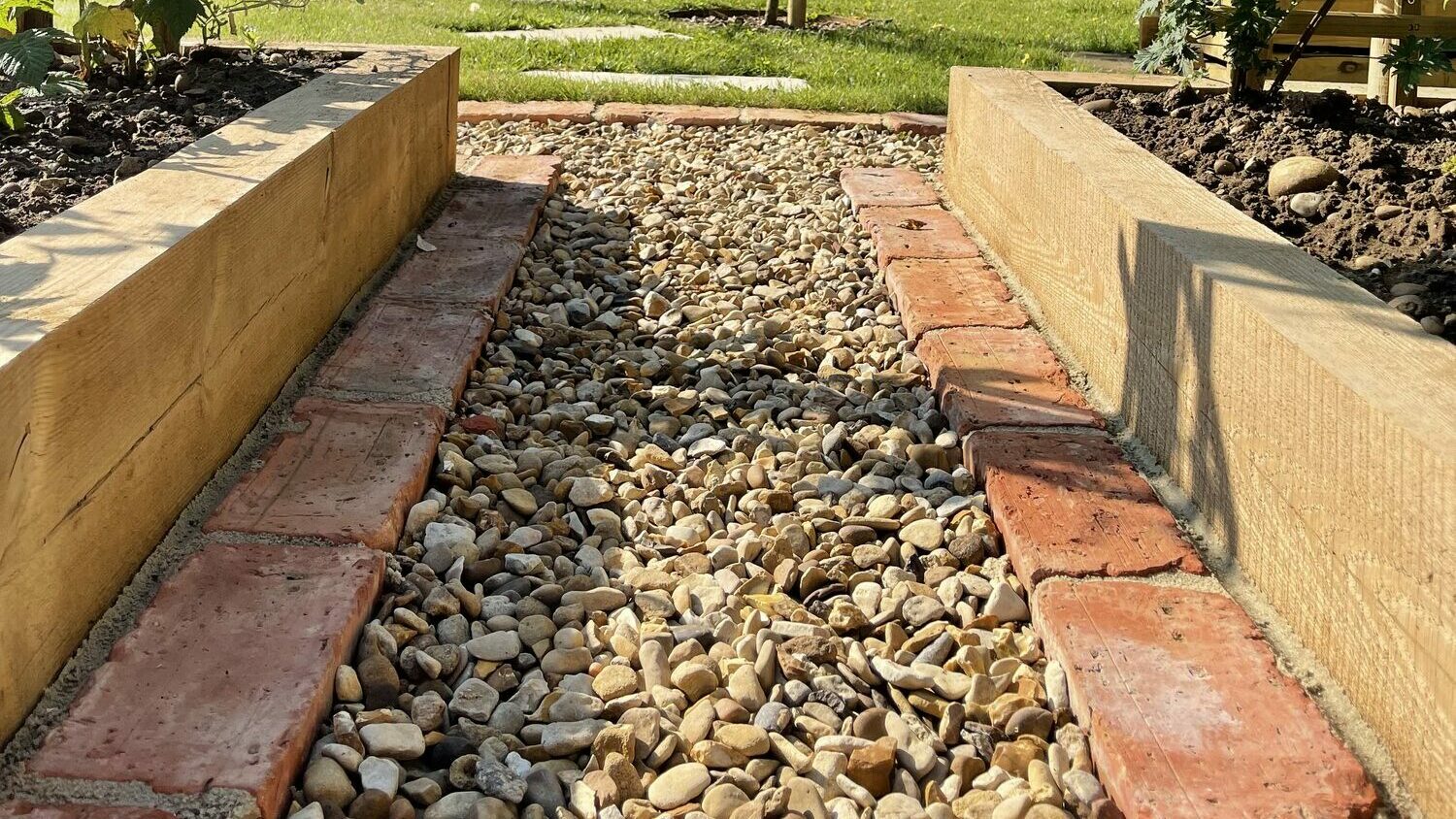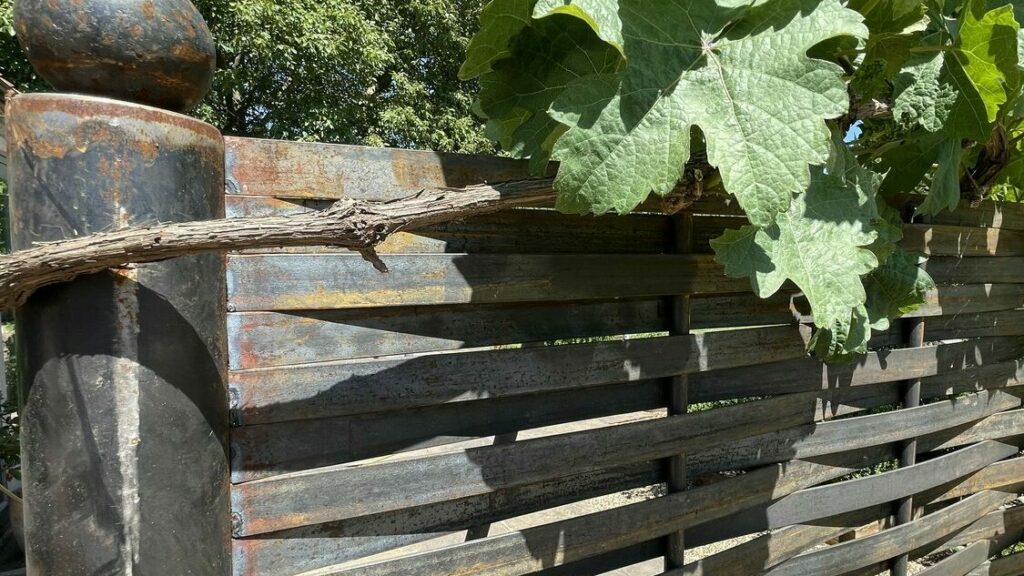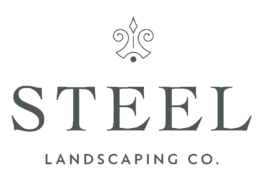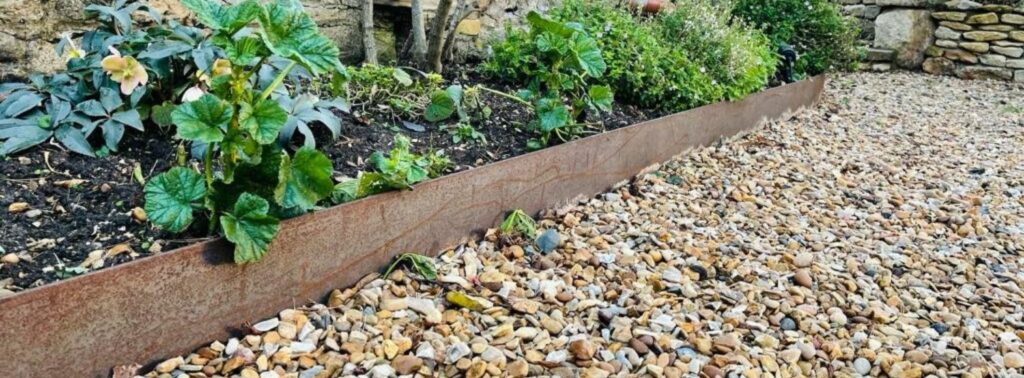Whether it’s driveways or patios, edging or raised beds, utilising the range of materials we’ll talk about in this guide can help you create the ideal outdoor space – both from an aesthetic and practical point of view.
Each material serves a different function, and in this blog, we’ll be walking you through a number of different outdoor materials and how they might benefit your outdoor spaces.
Landscaping Material #1: Concrete
Concrete is amongst the most economical and durable materials available in landscaping. Although, it must be formed, poured, finished, and cured as quickly as possible to ensure it can work effectively.
It’s also important to avoid pouring concrete in areas where the ground may be uneven or unstable. A good example of this is around trees, where the roots may push the concrete out of the ground or into areas where rainwater and moisture can’t drain as it usually would.
You should also clean concrete on a regular basis to remove stains, mildew, moss, and other debris.
No matter how carefully concrete is poured, it’s normal for it to crack in some areas. Cracks less than ½ inch wide, or those which are no longer getting bigger should be fine and can be patched with epoxy mixtures and concrete glue.
Benefits of Concrete:
- Durable.
- Low maintenance.
- Flexible – concrete can be formed into many different styles and colours.
Disadvantages of Concrete:
- Can be difficult to repair – depending on the nature of the cracks and damage that appears.
- Prone to cracks.
- Needs to be moved quickly once formed.
How Can I Use Concrete in Landscaping?
- Creating clean lines.
- Driveway foundations
- Recycled decorations – concrete is one of the most widely used materials in the world and it takes enormous energy to create. Reusing concrete to create pebbles, paths and decorative pieces is something certainly worth exploring to do your bit for the environment.
Landscaping Material #2: Timber
When you think of timber in the garden, your first thought is probably the old garden shed. And while it’s exactly the material you would use for that purpose – it is widely used as a practical and beautiful material in landscaping and gardening.
Wood adds a warming aesthetic and will often soften hardscapes. It’s sustainable too, and when sourced and used correctly has a much smaller carbon footprint than some other landscaping materials; it’s also relatively cheap.
Wood can be treated in a variety of different ways by using paints, vanishes and stains to give your landscape the unique look you’re after.
However, because wood is a natural element, the problem with weathering and rot over time is an unavoidable issue, even with consistent maintenance. This means that although you may save money in the short-term when compared to other more resistant landscaping materials, such as steel for example, you might end up paying more to keep replacing wood in the long term than you would during the entire lifecycle of steel structures.
Benefits of Timber:
- Aesthetically pleasing.
- Can be painted and stained to suit your tastes.
- Sustainable when sourced and used correctly.
Disadvantages of Timber:
- Requires a lot more upkeep than other materials on this list.
- Vulnerable to rot and weathering.
- Some woods are not suited to certain projects.
How Can I Use Timber in Landscaping?
- Decking.
- Steps.
- Structures such as sheds, conservatories or lean-tos.
- Garden furniture.
Landscaping Material #3: Brick

Bricks and rocks are an incredibly durable, attractive, and classic landscaping option – they can be mortared into place to create walls, and feature pieces, individually laid in strategic places or crushed down into the sand or small rocks as a decorative flourish in flower beds or around water features – the list truly is endless.
Because bricks, and mortar in particular, are sensitive to changes in weather conditions, it’s important to inspect any free-standing structures on a regular basis. Mildew and dirt can also form in shaded areas, so it’s a good idea to scrub them off. However, in most cases, any broken pieces can be replaced and cemented back into place with relative ease.
Bricks are made up of clay and are available in a variety of different colours, and while they aren’t usually expensive (most can be reclaimed from other projects), some aren’t designed for long-term outdoor if they’ve been designed as the inner layer of a brick wall.
If you’re looking to create an outdoor structure, patio, or something similar, it’s best to look out for smoother-facing bricks, which are designed to resist heavy weathering.
Benefits of Bricks:
- Traditional aesthetic.
- Easy to work with.
- Easy to clean.
- Incredibly flexible.
Disadvantages of Bricks:
- Some bricks aren’t suitable for long-term outdoor use.
- Regular cleaning is needed.
- Prone to chips and cracks.
How Can I Use Bricks in Landscaping?
- Edges.
- Paths.
- Decoration – ideal for framing flower beds and highlighting feature pieces.
- Walls.
- Brick paving.
- Brick structures – water features, bird baths, seats, and fire pits.
Landscaping Material #4: Steel

The steel industry developed into thriving commerce during the Industrial Revolution, and since then it has been commonplace in landscaping and garden designs. Hard-wearing and unique, steel’s dynamic versatility is widely appreciated by designers, gardeners, and landscapers all over the world.
No matter how it’s used, steel is a reliable and aesthetically pleasing material to work with – particularly when it is exposed to the elements and allowed to weather.
While it may sometimes be more costly as an initial investment, steel’s robust structure means that whatever you choose to use it for, you can enjoy the benefits for many years into the future. Particularly when you consider how often you’d need to replace timber structures in the same time period.
At Steel Landscaping Co. we have numerous products that have been fabricated and manufactured in the UK, using British steel, such as:
Steel Edging
The flexibility of steel means that our range of steel edging can be curved to section off different parts of your land or draw attention to raised beds or feature pieces.
Steel edging can also be used to form paths and patios, and create neat, sharp lines.
Steel Weave Fencing
Our steel weave fencing holds many advantages over traditional timber fencing, particularly willow weave fencing. Of course, wooden fencing will deteriorate over time and will require treatment to hold off rot and warping – but this is an inevitability.
A steel weave fence when left untreated will take on a natural patina of gold and browns, which brings a natural maturity to your landscape and helps the colours of your flowers and foliage really stand out.
Steel Estate Fencing
Traditional steel estate fencing was a very popular choice in the Victorian era and over recent years has become a firm favourite with landscapers and property developers looking to reclaim the traditional minimalism of an older, period property.
Our estate fencing comes in an array of finishing options and is made using British solid steel and will last a lifetime on your property. Because this kind of fencing can be installed on uneven and flat terrain, it is suitable for creating clean lines or mimicking the curvature of the landscape.
Steel Planters & Troughs
We have a range of steel planters and troughs. Whether you’re looking for a weathered patina look or a traditional lead effect – we have just the thing for you.
Unlike plastic or terracotta pots, steel planters are built to stand the test of time and hold up against the diversities of the British weather.
Benefits of Steel:
- Incredibly flexible.
- Will stand the test of time.
- Aesthetically pleasing.
- Strong.
- Little to no maintenance.
Disadvantages of Steel:
- Expensive initial outlay.
How Can I Use Steel in Landscaping?
- Paths.
- Decoration – ideal for raised beds.
- Fencing.
- Increasing wall coverage.
- Retaining walls.
- Screens.
- Freestanding panels.
- Planters.
Takeaways
There are many fantastic materials available to utilise for your landscaping project, but these four are certainly some of the most popular available.
Whether you’re looking for decorative elements or more permanent structures, there’s certainly a material out there that can suit your next landscaping project.
If you have any questions about anything we’ve covered in this blog, or you’d like so more information about our products or services, please don’t hesitate to get in touch with us today and we’ll be happy to help.

